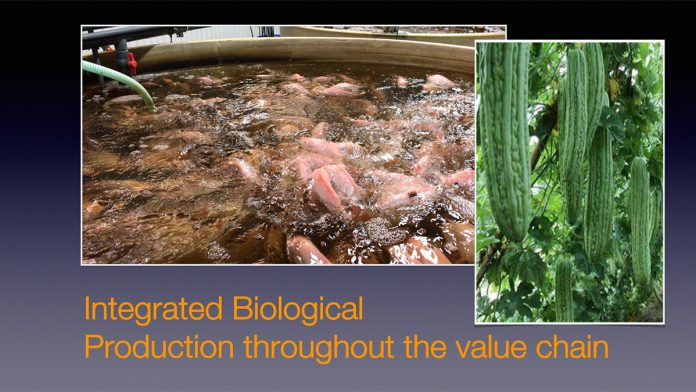An eco-friendly food production and healthier food will save the world in the view of horticulturist at the Swedish University of Agriculture, Håkan Sandin
Modern food production has two very negative effects on humanity. Firstly, it negatively affects our environment on a large scale. Secondly, it affects human health negatively on a large scale.
On the one hand, we have to start reviewing our food production and supply systems. It concerns all production in the world. We need to tackle the problem out of a system perspective because the problems are enormous and interconnected world-wide. However, it is not especially costly for humanity to correct what is wrong, but it is difficult and it will take time. It also needs a lot of hard work and innovation.
On the other hand, the paradigm shift is already here. Therefore, there is hope because much of the world’s food production is still small-scale and is based on thousands of well-proven production methods. Modern agriculture has proven over and over again that it is harmful to nature and in fact also for humanity. One example is the rich rice production landscape in Thailand (big in size as half of Sweden), which contains so much more than just rice production. It contains fish, fruits and berries, lots of green leaves, spices, animals, frogs, insects, you name it, all kinds of food. You should not underestimate the vast knowledge of the inhabitants of this ecosystem.
An ecosystem of the food supply that is rapidly changing and becoming dependent on fertilisers and chemicals, is poisoning a thousand-year-old agro-ecosystem. The peoples of this ecosystem and their knowledge of how to produce different crops and how to prepare them for consumption, keeping themselves healthy with the help of medicinal plants and other ingredients they find in the landscape. We are talking about the integrated biological production of food, a system whose task is to keep people and nature healthy.
It is understandable that we have to change our ways of living, simply because that is what people want, that is moving to cities for a better and more exciting life. But in this process, we have to learn from the old ways of surviving, which also means how we keep ourselves healthy.
Circular, sparse and mutualistic production systems
Integrated biological production, taking into account the full value chain, is the new invention. The old production systems were circular. Everything you produced was consumed where you lived, at least to a greater extent. Now, when we are moving to the cities we have to invent ways and means of producing in them, that is new production systems that are circular, sparse and mutualistic.
Innovations of all kinds are, therefore, necessary. They must be guided by the idea of making them circuit-based, sparse and mutualistic, thus, we can use all residual streams and resources. This applies to the entire value chain with primary production, transportation, processing, consumption and waste disposal, worldwide. In addition, food production and supply chains are the most energy consuming business in the world.
By scientifically studying these value chains, that is designing them from the start, so that we can take full advantage of all flows and reuse energy, organic matter, water and also utilise the surrounding resources of infrastructure and nature. This way, we will be able to create resource efficiency that strikes everything we know of today when producing food. This is a paradigm shift.
This development that has begun in Sweden and maybe also in other countries, will create a multi-billion industry, new primary production of food and food processing, energy supply innovations and a diversity of other innovations in urban areas. This will, in the end, create a circular, economical and mutualistic competitive industry for the production of food, where people live.
Healthy food and environment
The development is necessary because of the negative impact of large-scale agriculture on human health and environment. These negative effects are costing society in terms of the enormous amount of resources being used.
A single person who is ill due to poor food or poor consumption habits costs Swedish society 1 to 2 million SEK per year. Bad eating habits are one of the most common causes of disease. These people are, during their lifetime, increasingly ill for more than ten years. Therefore, we need to review what we produce and how we do it, all to reduce the harmful effects on human health and environment. We also have to continue the work at hand, by changing peoples consumption habits and their views on what to eat. Harmful production has to be prohibited.
Part of the solution
Designing ”food parks” close to the city or producing food in the city is part of the solution. Especially if we are performing the production in-house in a completely closed recirculating mode, in strict accordance with European environmental legislation.
It is very strange that modern agriculture is allowed to burden peoples’ health and nature to the extent that it actually does when in many cases, there are alternatives.
Can we save the environment when producing food?
Intensive, circular, sparse and mutualistic food production is the most important innovation of today and is part of the very obvious answer, supporting a paradigm shift. The answer, in our opinion, is yes.
- Moving production to the city whenever possible reduces the need for transport;
- Production in the city also reduces the need for production in open land and in open waters;
- By placing the production in urban areas where people live today, we can also benefit from surplus heat, electricity, organic materials, leftovers and other unused resources that need to be taken care of;
- We can also more easily employ people who are not currently in work;
- We can develop ecologically sustainable plant protection agents and systems for the protection of food crops. In-house production makes it easier and environmentally safe to use these agents;
- We can also develop ecologically sustainable fertilisers and sustainable systems for the nutritional supply of food crops! In-house production makes it easier and environmentally safe to use these fertilisers;
- We can also produce renewable fuels and lubricants using ecologically sustainable renewable materials, enabling us to create ecological safe transports;
- We can also produce feed for fish and other creatures using rest products from the city and forest industry. Producing the fish and other creatures in-house in urban areas and;
- By producing in-house, we are open to endless innovation possibilities by using high technology and ingenious solutions that the world has not seen. See the aquaponic system in Härnösand, Sweden below, as only one example of this.
Please note: this is a commercial profile
Håkan Sandin
Horticulturist
Swedish University of Agriculture
Tel: +46 703 168 920











